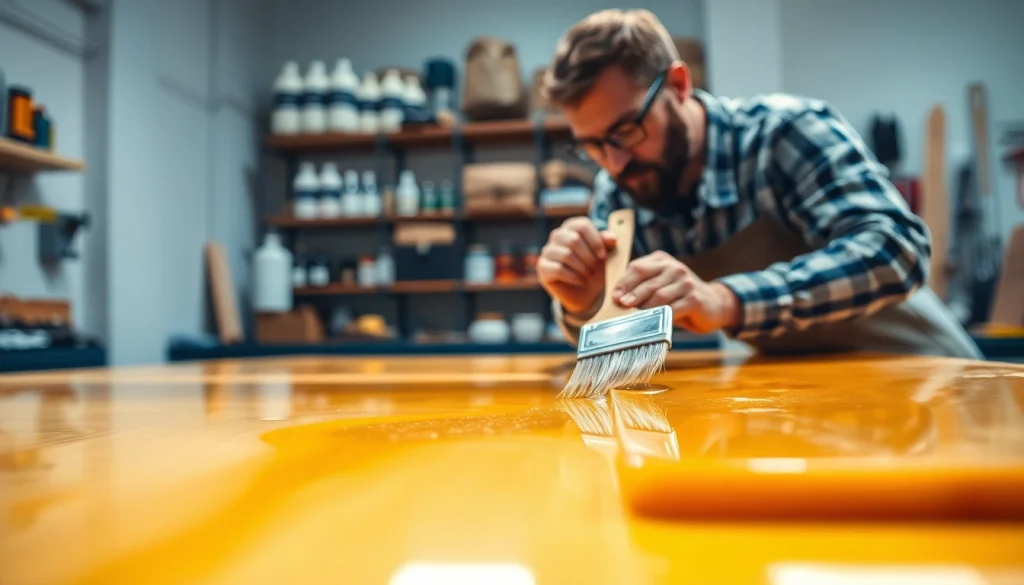Understanding Laminating Resin Types
Laminating resin serves as an essential material in various applications, including boat building, automotive manufacturing, and even artistic projects. It acts as a binding agent that allows for the layering of materials such as fiberglass or carbon fiber to achieve high strength and durability. This article delves into the different types of laminating resin, their benefits, and how they can be applied effectively in different scenarios. Whether you’re a professional in manufacturing or a hobbyist seeking to start a new project, understanding these varieties is crucial in selecting the correct material for your needs. To gain a comprehensive perspective, it’s valuable to examine both polyester and epoxy laminating resins closely. For more detailed insights on laminating resin, let’s explore these resin types further.
Polyester Laminating Resin: Benefits and Uses
Polyester laminating resin is one of the most commonly used types in the manufacturing and repair industries. This resin is known for its affordability and ease of use, making it a favorite among hobbyists and professionals alike. The key benefits of polyester laminating resin include:
- Cost-Effective: Polyester laminating resin is typically cheaper than epoxy resin. This makes it a practical choice for larger projects or those on a budget.
- Fast Curing: This type of resin cures quickly, which can help speed up the overall production process.
- Excellent Bonding: Suitable for bonding with various substrates, polyester resin provides a strong adhesion, particularly with fiberglass.
Uses for polyester laminating resin extend across multiple fields. It’s employed in the production of boats, car parts, and even industrial applications. Its combination of durability and cost efficiency makes it an integral choice for many.
Epoxy Laminating Resin: When to Choose This Option
Epoxy laminating resin, while somewhat pricier than polyester resin, comes with numerous advantages that often justify the cost. It is known for its superior mechanical properties and is ideal for applications requiring high strength and durability. Benefits of epoxy laminating resin include:
- High Strength: Epoxy resin provides a much stronger bond and is less prone to brittleness, making it suitable for demanding applications.
- Lower Shrinkage: When cured, epoxy tends to warp less than polyester, ensuring dimensional accuracy in the final product.
- Enhanced Chemical Resistance: Epoxy offers excellent resistance to solvents and chemicals, making it suitable for harsh environments.
This resin is commonly used in marine applications and where structural integrity is critical, such as in aerospace and automotive sectors. If your project demands strength, improved adhesion, or chemical resistance, then epoxy laminating resin is worth considering.
Comparative Analysis of Laminating Resin Types
When comparing polyester laminating resin and epoxy laminating resin, it is crucial to evaluate the specific requirements of your project. Below is a summary of key differences:
| Feature | Polyester Laminating Resin | Epoxy Laminating Resin |
|---|---|---|
| Cost | Lower | Higher |
| Cure Time | Fast | Moderate |
| Durability | Moderate | High |
| Shrinkage | Higher | Lower |
| Chemical Resistance | Moderate | High |
When selecting between these types, consider the specific application, desired durability, budget constraints, and whether chemical exposure is a factor.
Key Advantages of Using Laminating Resin
Strength and Durability: What You Can Expect
The primary benefits of using laminating resin revolve around the strength and durability it provides. Resins create robust composites by effectively bonding together layers of reinforcing materials. This results in products that can withstand heavy loads, resist impacts, and endure environmental factors, including moisture and UV exposure. The combination of materials allows engineers and designers to tailor the properties of the final product based on the specific demands of its application.
Cost Efficiency: Maximizing Your Budget with Laminating Resin
With various options available, choosing the right laminating resin can maximize your budget effectively. Polyester resin is the economical choice for larger projects due to its lower cost and adequate performance in many applications. However, the long-term advantages of epoxy resin can sometimes offset the initial investment, especially when enhanced strength and lower repair costs are considered. Evaluating the total cost of ownership—factoring in longevity, performance, and repairability—will help ensure you utilize your resources wisely.
Environmental Impact Considerations
In today’s environmentally conscious market, the environmental impact of materials used in manufacturing is a growing concern. Both polyester and epoxy resins have their environmental considerations. Polyester resin can emit volatile organic compounds (VOCs) during curing, contributing to air pollution. On the other hand, some epoxy formulations have developed to be more environmentally friendly. Choosing a resin with lower emissions or considering bio-based options can help mitigate environmental effects in your projects.
Application Techniques for Laminating Resin
Preparation: Setting Up Your Workspace
Before diving into a project with laminating resin, proper workspace preparation is vital. Ensure the area is well-ventilated and free of dust or contaminants. Gather all necessary materials, including the chosen resin, hardener (if applicable), mixing containers, brushes or rollers for application, and protective gear. Clean surfaces thoroughly and consider using mold release agents if working with molds to prevent adhesion.
Step-by-Step Guide to Applying Laminating Resin
The process of applying laminating resin can vary based on the specific project type. Here is a generalized step-by-step guide:
- Mixing the Resin: Follow the manufacturer’s instructions to mix the resin with the hardener adequately. Ensure to measure accurately for the best results.
- Applying the First Layer: Using a brush or roller, apply a layer of resin to your substrate or mold. Ensure even coverage without pooling.
- Layering Materials: If using reinforcement materials, lay them over the wet resin. Use a brush or roller to saturate the fibers thoroughly.
- Building Layers: Continue to apply additional layers as needed, allowing each layer to cure according to the manufacturer’s instructions.
- Finishing: Once all layers are applied and cured, finish the surface as needed, whether sanding, polishing, or adding further coatings.
Common Mistakes to Avoid When Using Laminating Resin
Many individuals encounter common pitfalls while working with laminating resin. Understanding these can lead to better project outcomes:
- Poor Mixing: Failing to mix the resin adequately can result in incomplete curing or performance issues. Always follow precise mixing ratios.
- Inadequate Ventilation: Not ensuring proper ventilation can introduce health hazards due to fumes released during curing.
- Skipping Surface Preparation: Not properly preparing the surface can lead to weak adhesion or peeling in the future.
- Ignoring Cure Times: Rushing through the cure process can compromise strength. Always allow the resin to cure fully before subjecting it to stress.
Innovative Projects Using Laminating Resin
Creating Custom Molds with Laminating Resin
If you’re interested in molding applications, laminating resin is ideal for creating durable and reusable molds. Start by preparing a model or pattern you wish to replicate. Apply a release agent to prevent adhesion, then layer the resin and appropriate reinforcement materials to create a sturdy mold. Once cured, you’ll have a strong mold ready for casting.
Building Durable Crafts: Case Studies
Various creative projects can successfully utilize laminating resin. Artists have crafted custom furniture, sculptures, and even jewelry using resin to create eye-catching designs. By leveraging the versatility of lamination, creators can embed objects within resin or design multilayered compositions that capture unique aesthetics.
Repairing Objects: Practical Applications of Laminating Resin
Laminating resin is exceptionally beneficial for repair applications, particularly in materials such as fiberglass and wood composites. Whether repairing a damaged boat hull or restoring a weathered wood deck, the resin can fill gaps, reinforce structures, and extend the useful life of items that have seen better days.
Maintenance and Safety Tips for Laminating Resin
Proper Storage of Laminating Resin
Storing laminating resin correctly is essential for maximizing its shelf life and maintaining performance. Keep resin in a cool, dry place, away from direct sunlight and moisture. It’s also important to keep resin tightly sealed to prevent contamination or hardening due to exposure to air.
Health and Safety Precautions
Safety should always be a priority when working with laminating resin. Always wear suitable protective gear, including gloves and masks, to prevent skin and respiratory exposure to fumes. Ensure your workspace is well-ventilated to mitigate inhalation risks. Consult the safety data sheets for your specific resin type for detailed safety guidelines.
Long-term Care: How to Extend the Life of Your Laminating Resin Projects
To ensure your projects utilizing laminating resin remain in excellent condition over time, regular maintenance is key. Periodically inspect for damage or degradation and perform repairs as needed. Clean surfaces gently, avoiding harsh chemicals which might degrade the resin over time. Most importantly, store and display objects in a manner that protects them from physical damage or environmental stressors.





